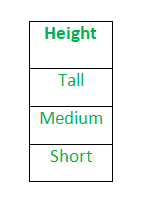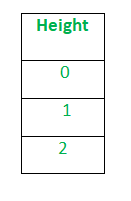Label Encoding of datasets in Python
In machine learning, we usually deal with datasets which contains multiple labels in one or more than one columns. These labels can be in the form of words or numbers. To make the data understandable or in human readable form, the training data is often labeled in words.
Label Encoding refers to converting the labels into numeric form so as to convert it into the machine-readable form. Machine learning algorithms can then decide in a better way on how those labels must be operated. It is an important pre-processing step for the structured dataset in supervised learning.
Example :
Suppose we have a column Height in some dataset.

After applying label encoding, the Height column is converted into:

where 0 is the label for tall, 1 is the label for medium and 2 is label for short height.
We apply Label Encoding on iris dataset on the target column which is Species. It contains three species Iris-setosa, Iris-versicolor, Iris-virginica.
# Import libraries import numpy as np import pandas as pd # Import dataset df = pd.read_csv('../../data/Iris.csv') df['species'].unique() |
Output:
array(['Iris-setosa', 'Iris-versicolor', 'Iris-virginica'], dtype=object)
After applying Label Encoding –
# Import label encoder from sklearn import preprocessing # label_encoder object knows how to understand word labels. label_encoder = preprocessing.LabelEncoder() # Encode labels in column 'species'. df['species']= label_encoder.fit_transform(df['species']) df['species'].unique() |
Output:
array([0, 1, 2], dtype=int64)
Limitation of label Encoding
Label encoding convert the data in machine readable form, but it assigns a unique number(starting from 0) to each class of data. This may lead to the generation of priority issue in training of data sets. A label with high value may be considered to have high priority than a label having lower value.
Example
An attribute having output classes mexico, paris, dubai. On Label Encoding this column, let mexico is replaced with 0 , paris is replaced with 1 and dubai is replaced with 2.
With this, it can be interpreted that dubai have high priority than mexico and paris while training the model, But actually there is no such priority relation between these cities here.
Python Example for Beginners
Two Machine Learning Fields
There are two sides to machine learning:
- Practical Machine Learning:This is about querying databases, cleaning data, writing scripts to transform data and gluing algorithm and libraries together and writing custom code to squeeze reliable answers from data to satisfy difficult and ill defined questions. It’s the mess of reality.
- Theoretical Machine Learning: This is about math and abstraction and idealized scenarios and limits and beauty and informing what is possible. It is a whole lot neater and cleaner and removed from the mess of reality.
Data Science Resources: Data Science Recipes and Applied Machine Learning Recipes
Introduction to Applied Machine Learning & Data Science for Beginners, Business Analysts, Students, Researchers and Freelancers with Python & R Codes @ Western Australian Center for Applied Machine Learning & Data Science (WACAMLDS) !!!
Latest end-to-end Learn by Coding Recipes in Project-Based Learning:
Applied Statistics with R for Beginners and Business Professionals
Data Science and Machine Learning Projects in Python: Tabular Data Analytics
Data Science and Machine Learning Projects in R: Tabular Data Analytics
Python Machine Learning & Data Science Recipes: Learn by Coding
R Machine Learning & Data Science Recipes: Learn by Coding
Comparing Different Machine Learning Algorithms in Python for Classification (FREE)
Disclaimer: The information and code presented within this recipe/tutorial is only for educational and coaching purposes for beginners and developers. Anyone can practice and apply the recipe/tutorial presented here, but the reader is taking full responsibility for his/her actions. The author (content curator) of this recipe (code / program) has made every effort to ensure the accuracy of the information was correct at time of publication. The author (content curator) does not assume and hereby disclaims any liability to any party for any loss, damage, or disruption caused by errors or omissions, whether such errors or omissions result from accident, negligence, or any other cause. The information presented here could also be found in public knowledge domains.
